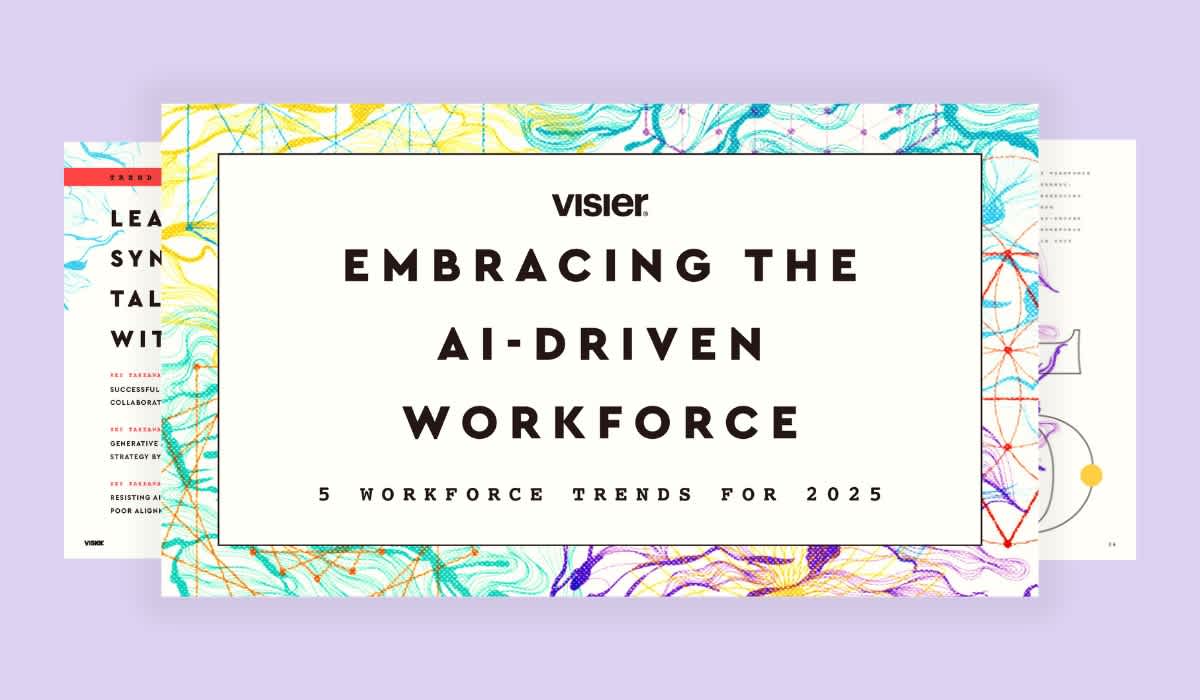The Hidden Truth Affecting Productivity: Nearly Half of Employees Say They Withhold Honest Feedback
New research confirms traditional employee engagement surveys fall short in measuring worker well-being, harming productivity. Read more here.

If you think you’re getting the whole truth from your employee engagement surveys, think again.
HR teams have historically relied on employee engagement surveys to gauge worker sentiment and identify opportunities to improve organizational productivity, agility, and profitability. But, as we learned in no uncertain terms, anyone expecting to gain an accurate understanding of true employee experience will be sorely disappointed.
Year after year, employee engagement surveys fail to surface the constellation of perspectives required to keep workers engaged, productive, and motivated to meet changing company needs. In fact, just a third (32%) of workers strongly agree their company’s employee engagement surveys accurately capture employee satisfaction in the first place.
Yet, despite the known shortcomings of these surveys, many HR teams are satisfied to hang their hats on this singular metric. As a result, HR leaders and other decision-makers focus their time and budget on what employees self-report rather than on developing a clear understanding of the root causes and truths behind these claims. This misalignment is detrimental, especially at a time when business productivity has grown stagnant, employee engagement is on the decline, and new talent pools are shallow.
Counteracting these critical business challenges and delivering on growth expectations is nearly impossible when decision-makers have an incomplete picture of employee well-being. And an overreliance on traditional employee engagement surveys is partially to blame.
As the pioneer of people analytics, Visier wanted to understand the limitations of traditional employee engagement surveys in capturing the full scope of employee sentiment, and what employers can do to improve their efforts. So, in October 2024, we surveyed 1,000 U.S.-based employees about their experiences taking these surveys, examining how accurately they reflect engagement levels and whether employees feel comfortable sharing honest feedback during the process.
Our survey showed that employee engagement surveys alone will never provide the full picture.
Just as customer experience (CX) isn’t defined by a single metric like an NPS score, employee experience (EX) requires a more comprehensive measurement strategy. Traditional engagement surveys certainly remain one input, but organizations must fortify their approach with AI-powered, data-driven insights that are more capable of uncovering key drivers of employee engagement and improving workforce productivity.

Nearly half of employees withhold honest feedback
Perhaps the biggest reason it’s a mistake to rely exclusively on employee engagement surveys to guide organizational strategy is employee honesty—or rather, the lack of it. Nearly half (47%) of employees say they often or occasionally feel pressured to withhold feedback when completing employee engagement surveys. Even more concerning is how these feelings of pressure translate into action. 20% of employees admit to occasionally holding back honest feedback during employee engagement surveys — and another 6% really or never provide honest feedback.
That means one out of every four employees injects inaccurate or incomplete information into the organization’s decision-making processes, which goes unchecked when these types of surveys are a company’s sole feedback mechanism.
A lack of trust in how survey responses are handled
Respondents’ confidence in their peers' honesty levels rates even lower. Nearly a third of employees (31%) say they don’t believe their colleagues are completely honest in their responses to their employer’s employee engagement surveys.
Naturally, some areas of work are more difficult for employees to be honest about than others. The topic respondents find most difficult to be honest about in employee engagement surveys is their overall job satisfaction, which can be a leading indicator of other key employee metrics like engagement, retention, and productivity.
Among respondents who don’t always provide honest feedback to employee engagement surveys, the top reason why they aren’t completely honest is that they don’t believe employee engagement surveys are ever really anonymous—which reflects a lack of trust in the organization's data management. This is followed by a lack of belief their feedback will have a meaningful impact and practical barriers like these surveys being a time drain.
Top reasons employees aren’t completely honest when responding to employee engagement surveys
No. 1 | I don’t believe employee engagement surveys are ever really anonymous | 37% |
No. 2 | I don’t believe my employer will act on my feedback in a meaningful way | 27% |
No. 3 (TIE) | Being honest in these types of surveys takes too long | 11% |
No. 3 (TIE) | I want my company to have a good reputation as an employer | 11% |
No. 4 | Being honest will worsen my experience as an employee | 8% |
No. 5 | The questions don’t allow me to fully express my true opinions | 5% |
A growing crisis of confidence among younger, junior-level employees
Generational trends indicate that dishonesty is on the rise during employee engagement surveys, especially among younger, junior-level workers who offer an important source of feedback on key employee issues and organizational needs.
For example, pressure to withhold honest feedback during employee engagement surveys is more pronounced among younger employees. 26% of millennials and 24% of Gen Zers report they often feel pressured to hold back, compared to only 15% of Gen Xers.
Likewise, more junior employees—presumably younger in age—are less likely to believe their colleagues are completely honest in their responses to their employer’s employee engagement surveys. Only 37% of entry-level employees and associates/analysts say their colleagues are completely honest in their responses, compared to 52% of managers and 61% of directors+.
Key takeaway: When employees feel they can’t share openly in traditional engagement surveys, the data generated reflects a distorted view of reality. Decision-makers thus have an incomplete and potentially misleading understanding of their workforce’s actual experiences and needs. This is especially harmful when this dishonest feedback is used to inform annual organizational strategy, programming, and budget plans.
What’s worse, these engagement surveys are time-consuming and expensive to conduct, potentially making the investment even more of a miss.
Employees most dishonest about job satisfaction and leadership
A critical failure of traditional employee engagement surveys is their inability to surface the insights managers require to support their teams and become more effective managers.
This feedback gap impacts not only managers but organizational leaders in general—leadership/executive management performance and relationships with managers are two of the top three topics employees find the most difficult to be honest about in employee engagement surveys. These challenges were even more pronounced than feedback on compensation/benefits and work-life balance.
Top topics employees find it most difficult to be honest about in employee engagement surveys
No. 1 | My overall job satisfaction | 36% |
No. 2 | Leadership or executive management performance | 33% |
No. 3 | My relationship with my manager | 30% |
No. 4 | Compensation and benefits | 24% |
No. 5 | Work-life balance | 20% |
The inability of employee engagement surveys to surface meaningful feedback for managers and other leaders is especially concerning when we factor in this year’s downward trend in worker motivation.
An employee-manager disconnect on rating emotional well-being
Lack of support from managers or leadership (28%) is a top-two factor currently demotivating or preventing employees from being productive at work, trailing only behind burnout or stress (35%). When decision-makers lack access to insights capable of improving their own performance and employee experience, this lack of support only deepens—and productivity levels suffer further.
The disconnect rears its ugly head when we compare how employees rate their emotional state at work to how they believe their managers would rank this factor.
Nearly half of employees (44%) say their managers would rate their current emotional state differently than they would—with nearly a quarter of employees (21%) saying their managers would inflate their emotional state.
Do you believe your manager would rate your current emotional state at work the same as you did?
Yes | 54% |
No, they'd rate it as better | 21% |
No, they'd rate it as worse | 6% |
I'm not sure | 17% |
I don't have a manager in my current role | 2% |
Alarmingly, employees who self-identify as either disengaged or burnt out at work are over four times more likely to say their manager would better rate their emotional state than employees who are motivated and engaged—further perpetuating a false sense of well-being among the segment of the workforce that needs intervention most.
Read more about this leadership divide in our recent white paper, The CEO Blindspot.

To boost productivity, employees want to see action
Faced with increased stress and limited support from managers, many employees are becoming disengaged, feeling disconnected from their work and stuck in roles that no longer inspire them to perform at their best. Organizations and HR teams must recognize the direct link between worker disengagement and diminished productivity levels and work harder to improve employee sentiment to drive business success.
To foster a productive, engaged workforce, leaders can’t overlook opportunities to translate employee feedback into direct action.
Unfortunately, this is a major organizational hurdle today and a leading deterrent during employee engagement surveys. Consider that the second most common reason employees aren’t completely honest when responding to employee engagement surveys is that they don’t believe their employer will act on their feedback in a meaningful way—and just 27% of respondents say HR always takes meaningful action based on employee engagement surveys.

Without candid feedback, leaders are flying blind when it comes to assessing and improving managerial performance. Without that transparency, managers lose out on critical insights into how their leadership style affects the team—making it harder to adapt, support employees effectively, and ultimately boost productivity.
Course correcting in this area is particularly important for organizations interested in improving employee productivity. The action employees would most like to see their company take to improve employee productivity over the next 12 months is providing regular updates on actions taken from employee engagement survey feedback (31%), followed by improved communication and transparency about company changes (26%).
Actions employees would most like to see their company take to improve employee productivity over the next 12 months
No. 1 | Provide regular updates on actions taken from employee engagement survey feedback | 31% |
No. 2 (TIE) | Improve communication and transparency about company changes | 26% |
No. 2 (TIE) | Increase compensation and benefits | 26% |
No. 3 | Offer more resources for employee well-being and mental health | 24% |
No. 4 (TIE) | Leverage data-driven insights to better address employee needs | 17% |
No. 4 (TIE) | Facilitate more career development and growth opportunities | 17% |
No. 5 | Support flexible working arrangements | 15% |
No. 6 | Provide better or more advanced tools and technologies in the workplace | 11% |
Better workforce insights with AI-powered people analytics
Too often, decision-makers lack a 360-degree understanding of how people, work, and business outcomes combine to help their organizations thrive. Focusing on gauging the health of your workforce solely through engagement surveys is myopic at best, and negligent at worst. Decision-makers need data-backed insights for the complete picture.
Surveys offer a starting point for understanding employees, but their overly qualitative nature means the insights they generate are not objective—and as our research demonstrates, not reliable.
Simply put, these surveys simply cannot be your single source of truth or your foundation for organizational planning.
AI-powered people analytics is the perfect complement to traditional employee engagement assessments, especially in a new and uncertain future. For companies still looking for the right place to apply AI-powered solutions, consider integrating generative AI as part of your HR toolkit—or what we at Visier call a “Workforce AI Edge.”
To truly understand your workforce, prioritize quantitative data sources first, such as employee turnover and retention rates, productivity metrics, and manager effectiveness. Then, supplement these trustworthy findings with the sentiment, context, and opinions that typically emerge from employee engagement surveys.
Equipped with real-time people insights that everyone at your organization can access, you and other leaders can better understand your employees and their business impact. From there, you can work alongside employees to increase engagement and productivity and guide your company through uncertainity with confidence.
Power true productivity by enhancing survey data with AI-powered insights
By layering survey feedback into AI-powered people analytics, you can gain a richer, more nuanced perspective on employee sentiment, enabling your organization to proactively address emerging issues rather than waiting for them to show up in annual survey responses (or never at all).
This approach tackles the root causes of employee disengagement and its impact on productivity, rebuilds trust, and fosters a culture of openness built to navigate today’s business performance erosion crisis.
To learn more about using people analytics to drive manager effectiveness, productivity, and employee engagement, get in touch.



